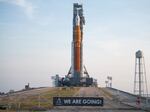
NASA's Space Launch System (SLS) rocket with the Orion spacecraft aboard is seen at the Kennedy Space Center on Aug. 17, 2022.
NASA via Getty Images
NASA’s new multibillion-dollar spacecraft successfully returned from the moon Sunday, one step closer to getting U.S. astronauts back on the moon by 2025.
The Orion capsule splashed down in the Pacific Ocean off the coast of Baja California at 9:40 a.m. PT, marking a successful phase one of NASA's Artemis program. Artemis 1 traveled 1.4 million miles, circling the moon, and returned within 25 and a half days, a feat no other human-rated spacecraft has achieved.
The capsule performed a "skip entry" descent where it dipped in and out of the atmosphere before re-entering to slow down the vehicle. This type of descent will also provide data for splashdown sites for future crewed missions, NASA spokesperson Rob Navias said on NASA's live stream on Sunday.
A key part of the descent was to test the spacecraft's heat shield against the "searing heat of entry" where temperatures built up to around 5,000 degrees Fahrenheit around Orion, Navias said. That's half as hot as the outer surface of the sun.
The successful splashdown keeps NASA's Artemis mission on track to put the first woman and first person of color on the lunar surface by 2025. But delays are not out of the equation, as seen in the months leading up to the capsule launch.
NASA delayed the Artemis 1 mission for several months due what seemed like an engine issue at the time, a liquid hydrogen leak, and then a hurricane. The mission finally launched Nov. 16.
The lunar program, named after Apollo's twin sister, hopes to revitalize some of the glory that NASA's previous moon-landing missions amassed a half-century ago. An estimated 600 million people tuned in to watch the Apollo 11 landing in July 1969, when Neil Armstrong became the first human to walk on the moon.
"It seems fitting that we would honor Apollo with the new legacy of the Artemis generation and this mission today," Catherine Koerner, deputy associate administrator for the Exploration Systems Development Mission Directorate, said on Sunday.
The next phase of the Artemis program will send the first crewed capsule around the moon and back, without landing on the moon, in 2024. NASA then aims to use the Orion capsule and a SpaceX human landing system to land astronauts on the moon for phase three of the program by 2025. The contract with Elon Musk's company is valued at nearly $2.9 billion.
NASA's inspector general, Paul Martin, said each of its first three flights will cost more than $4 billion, not including billions more in development costs. And by the end of fiscal 2025, NASA estimates it will have spent $93 billion on the Artemis missions.
Copyright 2022 NPR. To see more, visit https://www.npr.org.